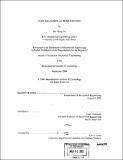| dc.contributor.advisor | Carol Livermore. | en_US |
| dc.contributor.author | Au, Hin Meng, 1977- | en_US |
| dc.contributor.other | Massachusetts Institute of Technology. Dept. of Mechanical Engineering. | en_US |
| dc.date.accessioned | 2006-03-24T18:38:32Z | |
| dc.date.available | 2006-03-24T18:38:32Z | |
| dc.date.copyright | 2004 | en_US |
| dc.date.issued | 2004 | en_US |
| dc.identifier.uri | http://hdl.handle.net/1721.1/30304 | |
| dc.description | Thesis (S.M.)--Massachusetts Institute of Technology, Dept. of Mechanical Engineering, 2004. | en_US |
| dc.description | Includes bibliographical references (leaves 99-100). | en_US |
| dc.description.abstract | This thesis examines and demonstrates self-assembly of MEMS components on the 25 micron scale onto substrates using the capillary force of solder. This is an order of magnitude smaller than current solder self-assembly in the literature. This thesis also examines self-assembly of high aspect ratio (2:1) microfabricated structures, which poses a greater challenge in terms of alignment and orientation compared to self-assembly of flat structures. The goal of the assembly is to construct a DEP-based cell trap, which consists of sets of high aspect ratio conducting posts on a Pyrex substrate, along with electrical connections to the posts. The posts and substrates are fabricated separately and then combined together through a self-assembly process. The posts are made of silicon and are 25 Im in diameter and 50 plm tall with a thin gold cap on one end to serve as a wetting site. The substrates are Pyrex wafers which are patterned with arrays of binding sites and electrical connections, and selectively coated with a low melting point bismuth solder alloy on the binding sites. Self-assembly of the posts onto the substrate is then driven by the free surface energy minimization of solder when the gold-capped ends of the silicon posts come into contact with the solder bumps. In this project, self-assembly has been successfully demonstrated with a yield of about 50%. | en_US |
| dc.description.abstract | (cont.) However, it also becomes increasingly difficult to control component placement and orientation at these small size scales, because deviations in components and sites from their ideal geometries become relatively pronounced as feature size is reduced. It is observed that post concentration, agitation, and solder wetting of the substrate and posts binding sites are critical for successful assembly. Solder de-wetting, and the peeling of gold caps due to prolonged HF exposure, also limits the yield and the orientation of the assembled posts. | en_US |
| dc.description.statementofresponsibility | by Hin Meng Au. | en_US |
| dc.format.extent | 100 leaves | en_US |
| dc.format.extent | 9283181 bytes | |
| dc.format.extent | 5024649 bytes | |
| dc.format.mimetype | application/pdf | |
| dc.format.mimetype | application/pdf | |
| dc.language.iso | eng | en_US |
| dc.publisher | Massachusetts Institute of Technology | en_US |
| dc.rights | M.I.T. theses are protected by copyright. They may be viewed from this source for any purpose, but reproduction or distribution in any format is prohibited without written permission. See provided URL for inquiries about permission. | en_US |
| dc.rights.uri | http://dspace.mit.edu/handle/1721.1/7582 | |
| dc.subject | Mechanical Engineering. | en_US |
| dc.title | Solder self-assembly for MEMS fabrication | en_US |
| dc.title.alternative | Solder self-assembly for microelectromechanical systems fabrication | en_US |
| dc.type | Thesis | en_US |
| dc.description.degree | S.M. | en_US |
| dc.contributor.department | Massachusetts Institute of Technology. Department of Mechanical Engineering | |
| dc.identifier.oclc | 61049849 | en_US |
